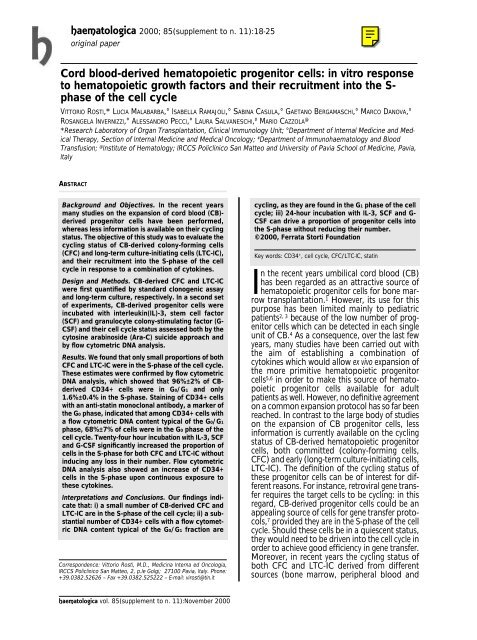Journal of Hematology - Supplements - Haematologica
Journal of Hematology - Supplements - Haematologica
Journal of Hematology - Supplements - Haematologica
Create successful ePaper yourself
Turn your PDF publications into a flip-book with our unique Google optimized e-Paper software.
haematologica 2000; 85(supplement to n. 11):18-25<br />
original paper<br />
Cord blood-derived hematopoietic progenitor cells: in vitro response<br />
to hematopoietic growth factors and their recruitment into the S-<br />
phase <strong>of</strong> the cell cycle<br />
VITTORIO ROSTI,* LUCIA MALABARBA,° ISABELLA RAMAJOLI,° SABINA CASULA,° GAETANO BERGAMASCHI,° MARCO DANOVA,°<br />
ROSANGELA INVERNIZZI,° ALESSANDRO PECCI,° LAURA SALVANESCHI, # MARIO CAZZOLA @<br />
*Research Laboratory <strong>of</strong> Organ Transplantation, Clinical Immunology Unit; °Department <strong>of</strong> Internal Medicine and Medical<br />
Therapy, Section <strong>of</strong> Internal Medicine and Medical Oncology; # Department <strong>of</strong> Immunohaematology and Blood<br />
Transfusion; @ Institute <strong>of</strong> <strong>Hematology</strong>; IRCCS Policlinico San Matteo and University <strong>of</strong> Pavia School <strong>of</strong> Medicine, Pavia,<br />
Italy<br />
ABSTRACT<br />
Background and Objectives. In the recent years<br />
many studies on the expansion <strong>of</strong> cord blood (CB)-<br />
derived progenitor cells have been performed,<br />
whereas less information is available on their cycling<br />
status. The objective <strong>of</strong> this study was to evaluate the<br />
cycling status <strong>of</strong> CB-derived colony-forming cells<br />
(CFC) and long-term culture-initiating cells (LTC-IC),<br />
and their recruitment into the S-phase <strong>of</strong> the cell<br />
cycle in response to a combination <strong>of</strong> cytokines.<br />
Design and Methods. CB-derived CFC and LTC-IC<br />
were first quantified by standard clonogenic assay<br />
and long-term culture, respectively. In a second set<br />
<strong>of</strong> experiments, CB-derived progenitor cells were<br />
incubated with interleukin(IL)-3, stem cell factor<br />
(SCF) and granulocyte colony-stimulating factor (G-<br />
CSF) and their cell cycle status assessed both by the<br />
cytosine arabinoside (Ara-C) suicide approach and<br />
by flow cytometric DNA analysis.<br />
Results. We found that only small proportions <strong>of</strong> both<br />
CFC and LTC-IC were in the S-phase <strong>of</strong> the cell cycle.<br />
These estimates were confirmed by flow cytometric<br />
DNA analysis, which showed that 96%±2% <strong>of</strong> CBderived<br />
CD34+ cells were in G0/G1 and only<br />
1.6%±0.4% in the S-phase. Staining <strong>of</strong> CD34+ cells<br />
with an anti-statin monoclonal antibody, a marker <strong>of</strong><br />
the G0 phase, indicated that among CD34+ cells with<br />
a flow cytometric DNA content typical <strong>of</strong> the G0/G1<br />
phase, 68%±7% <strong>of</strong> cells were in the G0 phase <strong>of</strong> the<br />
cell cycle. Twenty-four hour incubation with IL-3, SCF<br />
and G-CSF significantly increased the proportion <strong>of</strong><br />
cells in the S-phase for both CFC and LTC-IC without<br />
inducing any loss in their number. Flow cytometric<br />
DNA analysis also showed an increase <strong>of</strong> CD34+<br />
cells in the S-phase upon continuous exposure to<br />
these cytokines.<br />
Interpretations and Conclusions. Our findings indicate<br />
that: i) a small number <strong>of</strong> CB-derived CFC and<br />
LTC-IC are in the S-phase <strong>of</strong> the cell cycle; ii) a substantial<br />
number <strong>of</strong> CD34+ cells with a flow cytometric<br />
DNA content typical <strong>of</strong> the G0/G1 fraction are<br />
Correspondence: Vittorio Rosti, M.D., Medicina Interna ed Oncologia,<br />
IRCCS Policlinico San Matteo, 2, p.le Golgi; 27100 Pavia, Italy. Phone:<br />
+39.0382.52626 – Fax +39.0382.525222 – E-mail: virosti@tin.it<br />
cycling, as they are found in the G1 phase <strong>of</strong> the cell<br />
cycle; iii) 24-hour incubation with IL-3, SCF and G-<br />
CSF can drive a proportion <strong>of</strong> progenitor cells into<br />
the S-phase without reducing their number.<br />
©2000, Ferrata Storti Foundation<br />
Key words: CD34 + , cell cycle, CFC/LTC-IC, statin<br />
In the recent years umbilical cord blood (CB)<br />
has been regarded as an attractive source <strong>of</strong><br />
hematopoietic progenitor cells for bone marrow<br />
transplantation. 1 However, its use for this<br />
purpose has been limited mainly to pediatric<br />
patients 2, 3 because <strong>of</strong> the low number <strong>of</strong> progenitor<br />
cells which can be detected in each single<br />
unit <strong>of</strong> CB. 4 As a consequence, over the last few<br />
years, many studies have been carried out with<br />
the aim <strong>of</strong> establishing a combination <strong>of</strong><br />
cytokines which would allow ex vivo expansion <strong>of</strong><br />
the more primitive hematopoietic progenitor<br />
cells 5,6 in order to make this source <strong>of</strong> hematopoietic<br />
progenitor cells available for adult<br />
patients as well. However, no definitive agreement<br />
on a common expansion protocol has so far been<br />
reached. In contrast to the large body <strong>of</strong> studies<br />
on the expansion <strong>of</strong> CB progenitor cells, less<br />
information is currently available on the cycling<br />
status <strong>of</strong> CB-derived hematopoietic progenitor<br />
cells, both committed (colony-forming cells,<br />
CFC) and early (long-term culture-initiating cells,<br />
LTC-IC). The definition <strong>of</strong> the cycling status <strong>of</strong><br />
these progenitor cells can be <strong>of</strong> interest for different<br />
reasons. For instance, retroviral gene transfer<br />
requires the target cells to be cycling: in this<br />
regard, CB-derived progenitor cells could be an<br />
appealing source <strong>of</strong> cells for gene transfer protocols,<br />
7 provided they are in the S-phase <strong>of</strong> the cell<br />
cycle. Should these cells be in a quiescent status,<br />
they would need to be driven into the cell cycle in<br />
order to achieve good efficiency in gene transfer.<br />
Moreover, in recent years the cycling status <strong>of</strong><br />
both CFC and LTC-IC derived from different<br />
sources (bone marrow, peripheral blood and<br />
haematologica vol. 85(supplement to n. 11):November 2000

















